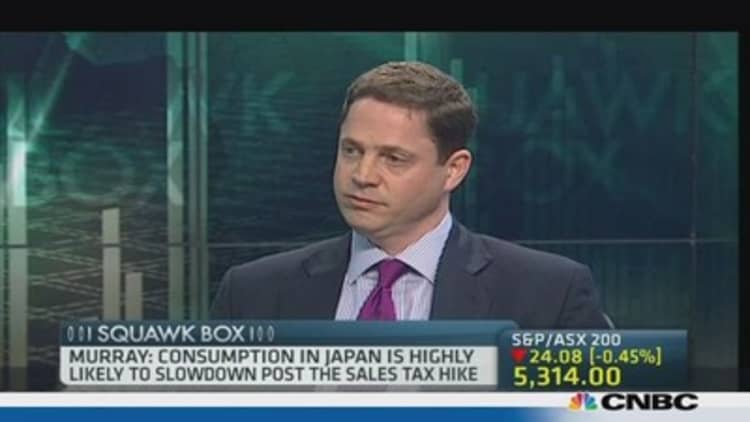The Bank of Japan (BoJ), which has largely been in wait-and-see mode since launching an unprecedented monetary easing program last April, could be on the brink of unleashing fresh stimulus, say economists.
"We expect the BoJ to implement additional quantitative and qualitative easing measures some time during the second quarter - most likely in April - in order to counter downside risks to economic growth from the consumption tax hike in April," Takuji Aida, an economist at Société Générale said in a report on Wednesday.
(Read more: BOJ minutes: Economy, prices on track with forecasts)
The BoJ holds its next monetary policy meeting on April 7-8 - a few days after the country's consumption tax increase from 5 to 8 percent takes effect on April 1.
Aida cites five key reasons the central bank will act soon. Firstly, he says the market's inflation expectations are currently below the BoJ's price stability target of 2 percent.
"The QQE [quantitative and qualitative easing] policy has pushed up the market's expectation that the economy will soon exit deflation. However, the problem is that the market's expectation is much weaker than the BoJ's commitment to it," Aida said.
For example, the BoJ's consumer price index (CPI) forecast is 1.9 percent for the 2015 fiscal year, while the market consensus is only 1.0 percent, according to the bank.
Secondly, the BoJ needs to act quickly if is to fulfill its goal of achieving 2 percent inflation by 2015, Aida added.
(Read more: A good start to the year for Japan's economy)
"Earlier this year, the BoJ said it sees inflation will be around 1.25 percent 'for some time' - which means around six months. Six months seems too long for the BoJ to fulfill its commitment of achieving a stable inflation rate of 2 percent," Aida said.
Thirdly, the BoJ needs to demonstrate its conviction that it will do whatever it takes to end deflation.
"If its policy is one intended to change expectations, we believe that unless the BoJ continues to go beyond the market's expectations - then those expectations will not come anywhere close to the BoJ's target," said Aida.

Fourthly, additional monetary easing is needed to support the other two arrows of Prime Minister Shinzo Abe's plan to revive Japan economy - fiscal stimulus and structural reforms.
Lastly, Aida said easing monetary policy further after long-term real interest rates have turned negative would provide a further boost to the economic recovery. Currently, the 10-year real interest rate in Japan is -0.2 percent.
Timing of stimulus
Economists are split over the timing of when the BoJ could unveil fresh stimulus, with some predicting the central bank is likely to wait for economic data to assess the impact of the sales-tax hike first.
(Read more: Can Japan's rally continue without a third arrow?)
"While the outlook hinges on economic and market trends following the VAT [value added tax] hike, we continue to believe the BoJ may be pressured to take additional easing action after the consumption tax hike in April 2014, with the earliest timing being the June monetary policy meeting when post-tax hike data will first be available for review," Naohiko Baba, chief Japan economist at Goldman Sachs wrote in a note this month.
Morgan Stanley shared a similar view, saying the BoJ will only embark on additional easing after the impact of the consumption tax hike is clear - in July "at the earliest."
When the BoJ does ease, Morgan Stanley expects an accelerated expansion of the monetary base, by raising the pace of purchasing Japanese government bonds (JGBs) from 50 trillion yen ($488 billion) to around 60 trillion yen per year, ETFs from 1 trillion yen to at least 2 trillion yen per year, and J-REITs.
—By CNBC's Ansuya Harjani; Follow her on Twitter @Ansuya_H


